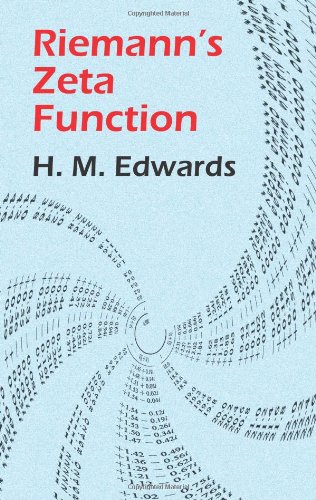Riemann's Zeta Function ebook
Par wilford karen le samedi, avril 30 2016, 18:01 - Lien permanent
Riemann's Zeta Function by H. M. Edwards


Riemann's Zeta Function H. M. Edwards ebook
Format: pdf
Page: 331
ISBN: 0122327500, 9780122327506
Publisher: Academic Press Inc
Apparently it tends to infinity when the argument is 1. I understand that the zeta function for Re(s)> 1 is defined as the sum from one to infinity of 1/n^s. It has zeros at the negative even integers (i.e. Afterwards, they demanded that I should explain next week what on earth the zeroes of the Riemann zeta function had to do with counting primes and what all this nonsensical 'music of the primes' was about. Assuming the Riemann hypothesis, we obtain upper and lower bounds for moments of the Riemann zeta-function averaged over the extreme values between its zeros on the critical line. The quadratic Mandelbrot set has been referred to as the most complex and beautiful object in mathematics and the Riemann Zeta function takes the prize for the most complicated and enigmatic function. ]Is there some philosophy about it? I goes like this: 1 + 1/2 + 1/3 + 1/4 + 1/5 + . And, in RH, there is an important sequence of numbers called : the moments of the Riemann zeta function. On frequent universality of Riemann zeta function and an answer to the Riemann Hypothesis [INOCENTADA]. I guess it is about time to get to the zeta function side of this story, if we're ever going to use Farey sequences to show how you could prove the Riemann hypothesis. See within this graph the narrative structure of every tale you've ever read. Graph the Riemann Zeta Function and watch the recursive spiraling through recursive loops, only to miraculously escape the predictable. These are called the trivial zeros. My second post this day is a beautiful relationship between the Riemann zeta function, the unit hypercube and certain multiple integral involving a “logarithmic and weighted geometric mean”. I'm not savvy with Tex, so work with me here. The Riemann zeta function ζ(s) is defined for all complex numbers s � 1 with a simple pole at s = 1. How do I work out a formula for Re(s)< 1, and more importantly, Re(s)<0? �Although the Riemann zeta-function is an analytic function with [a] deceptively simple definition, it keeps bouncing around almost randomly without settling down to some regular asymptotic pattern. So I was reading The Music of the Primes and I obviously came across the Zeta function. Riemann's ten-page-long paper “Über die Anzahl der Primzahen unter einer gegebener Gröβe” has great influence on modern number theory.